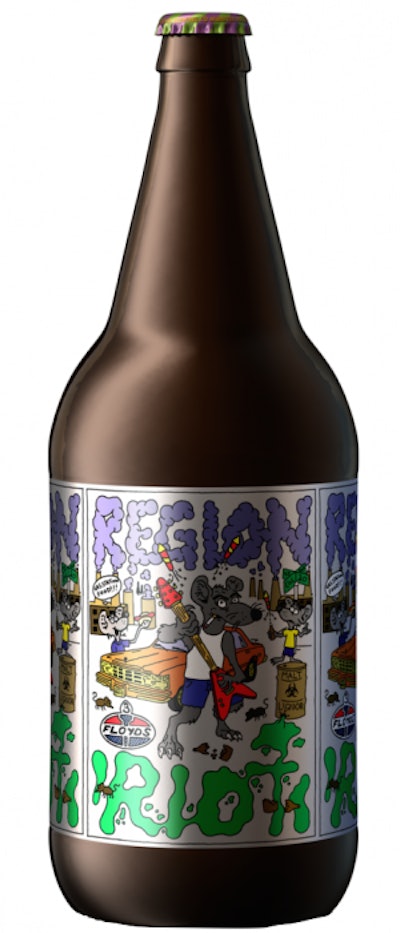
There were probably more booths at the Craft Brewers Conference exhibiting labels than any other single category. Their popularity is driven largely by the still growing popularity of cans for craft brews. The problem with cans, of course, is that minimum order requirements don’t mesh with the modest volume requirements of craft brewers. But if a brewery can order a truck load of undecorated bright stock cans and then use a label that makes it possible to fill them with whatever beer variety is desired, now you’re talking. Yes, there is a cost attached to the label—at CBC I heard it might be anywhere from 22 cents to 40 cents. To put it in perspective, Budweiser cans with direct print decoration cost about a nickel each. Still, the bottom line for most craft brewers is that the economics greatly favor buying bright stock and labeling 1,000 cans of pilsner and 500 cans of porter rather than paying for two truckloads of printed cans.
One of the more intriguing labels shown was at the Kurz booth. It was converted by Printing Arts with an exciting new technology from Kurz that’s called Digital Metal, which combines foiling capabilities with existing toner-based digital printing. This allows a converter like Printing Arts to incorporate foil into designs on a variety of substrates far more readily than if conventional foil stamping had to be relied upon. Armed with this digital capability, short runs suddenly make economic sense, and in fact the paper label we saw at the Kurz booth was for a special beer that Munster, IN-based 3 Floyds tested in a quantity of less than 1,000 bottles. The label was applied by hand.
According to Doug Still of Printing Arts, production of the label was a three-step process. First the sheet-fed labels are run through an HP Indigo 5600 digital press that lays down a black toner wherever the label design calls for foil. Then the labels are taken to the Kurz Digital Metal system, which reactivates the toner so that foil adheres only to the spots that had the toner laid down. Finally, the sheets are returned to the Indigo digital press for overprint.
Still says that Printing Arts is the first to have the Kurz technology in North America. “It’s great for market research and sampling,” says Still. “The sweet spot is probably runs of 1,500 or less.” See this website for more information, including a video.
On the full-body shrink sleeve side of things, Century Label was promoting a clever limited-run brand called Tip-Off Ale that Indianapolis-based Sun King Brewery produced in partnership with their hometown NBA team the Indiana Pacers. The German-style Altbier debuted on tap and in cans at the Pacers’ first home game of the 2015 season and was available until supplies ran out at all events at the Fieldhouse in which the Pacers play. Working with Century Label, Sun King was able to quickly develop and roll out a new product that was completely unique, says brewery Co-owner Clay Robinson. The flexibility afforded by sleeve-labeling allowed the brewery to quickly experiment with new ideas in brewing and, just as important, utilize the shape, shine, and shelf appeal of the prime label to draw the consumer to the brand. By capitalizing on digital printing technology in this way, says Robinson, the brewery is able to “be whoever we wanted to be, produce what we want to produce—passionately.” A nice summary of the project is available in this video.
Another common theme that emerged out of CBC is how many craft brewers have their labeling done for them by an outside party, often the same converter that supplies the label itself. At the Blanco Labels booth, for example, Kurt Webber explained to me that one of his craft brew customers had always used bottles with graphics applied by Applied Ceramic Labeling. This is the application of ceramic inks to the glass so that a permanent fusion of ink to glass can be carried out in a high-temperature ovens. But as questions have risen concerning the toxicity of some of the inks used in ACL—not to mention the amount of energy required for the ovens—this particular beer maker decided to switch to clear pressure-sensitive labels that Blanco Labels applies. At the 0:43 mark of this video, the Red Owl labels are seen being applied by a pressure-sensitive labeler from Pack Leader, another exhibitor at CBC.
The S3 Steam Machine from Ryback & Ryback was designed with converters in mind because it lets them apply a sample shrink sleeve label to a bottle or can and shrink it down properly instead of relying on a hair dryer, a heat gun, boiling water, or some other jury-rigged solution. So it’s a way of creating perfect samples every time, samples that look professionally applied. Essentially a boiler and an aluminum steam chamber, the S3 Steam Machine easily and quickly steams containers one after another, with steam time per container averaging about 9 seconds. Ryback & Ryback even makes available an additional cap if bottles larger than 750 mL need to be labeled. See the video here.



















